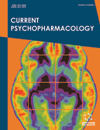- Home
- A-Z Publications
- Current Psychopharmacology
- Previous Issues
- Volume 2, Issue 1, 2013
Current Psychopharmacology - Volume 2, Issue 1, 2013
Volume 2, Issue 1, 2013
-
-
Antipsychotics in the Treatment of Impulsivity in Personality Disorders and Impulse Control Disorders
More LessAuthors: Silvio Bellino, Paola Bozzatello, Elena Brignolo and Filippo BogettoIn the last years, second generation antipsychotics have shown to be useful in the treatment of disorders with predominant impulse dyscontrol symptoms, in particular borderline personality disorder (BPD) and impulse control disorders (ICDs). The present review aims to provide a comprehensive examination of data from randomized controlled trials (RCTs), open label studies, and case reports concerning efficacy a Read More
-
-
-
Are Antipsychotics Useful in the Treatment of Anorexia Nervosa? A Review of the Literature
More LessAuthors: Michele Fabrazzo, Palmiero Monteleone and Mario MajA review of the literature on the use of second generation antipsychotics (SGA) in adolescent and adult patients with anorexia nervosa (AN) is presented. Open-label studies and case reports suggested beneficial effects of variable doses of olanzapine, quetiapine, risperidone and aripiprazole in AN subjects. Randomized, double-blind, controlled studies conducted mainly with olanzapine demonstrated its efficacy on Read More
-
-
-
Risperidone Long-Acting Injection in the Treatment of First Episode Schizophrenia
More LessAuthors: P. Rocca, L. Sandei, I. M. Bava and T. FrieriPharmacological treatments of first episode schizophrenia are of particular relevance because most clinical and psychosocial deterioration with cognitive decline and changes in brain volume occurs in the first five years of disease onset. Although the efficacy of antipsychotic maintenance treatment has been demonstrated to reduce risk of relapse, nonadherence is common even in first episode schizophrenia patients. Anti Read More
-
-
-
Antipsychotics and Cognitive Functioning: A Critical Review
More LessAuthors: Paolo Stratta, Ilaria Riccardi and Alessandro RossiCognitive dysfunction underpins some of the psychopathology of schizophrenia, as well as contributes to the patient's impaired social and vocational functioning and has now been recognized as an intrinsic dimension linked to functional outcome. Despite a general consensus on the capacity of antipsychotics to improve the psychopathology of schizophrenia, the dispute concerning their impact on cognitive function is Read More
-
-
-
Use of Atypical Antipsychotics as Mono/Polytherapy with Mood Stabilizers for the Treatment of Bipolar Disorder. An Update
More LessAuthors: A. Carlo Altamura, Beatrice Benatti and Bernardo Dell'OssoOver the last decade, the class of the atypical antipsychotics has become the gold standard for the treatment of bipolar disorder (BD), at least for its manic/mixed phases. This phenomenon has different explanations: first, the number of compounds with formal approvals for BD is higher in comparison with other mood-stabilizers including lithium and anticonvulsants. Second, the sample size of randomized controlled trials as Read More
-
-
-
Modulation of Arachidonic Acid Metabolism in Niemann-Pick Disease Type C Cells
More LessNiemann-Pick disease type C (NPC) is a neurodegenerative lipid storage disorder caused by mutations in NPC1 or NPC2 genes. Loss of function of either protein results in the endosomal accumulation of cholesterol and other lipids. The mechanism of neuro-toxicity induced by the lipid storage has not been well elucidated. Here, we report that NPC1-deficient Chinese hamster ovary cells exhibit increased release of arachidonic Read More
-
-
-
Polyunsaturated Fatty Acids and their Related Enzymes in Postmortem Brain Tissues of Patients with Psychiatric Disorders
More LessAuthors: Kei Hamazaki, Tomohito Hamazaki and Hidekuni InaderaThe first study on fatty acid composition of the postmortem brains of patients with psychiatric disorders was performed by Horrobin et al. in 1991, who found abnormalities in polyunsaturated fatty acids (PUFAs) in patients with schizophrenia. About a decade later, research in this field was re-started by Yao et al., followed by a number of other research groups. The results seem to show that the PUFA changes in psychiatric dis Read More
-
-
-
Polyunsaturated Fatty Acids and their Metabolites in Neural Development and Implications for Psychiatric Disorders
More LessAuthors: Nobuyuki Sakayori and Noriko Osumin-6 and n-3 polyunsaturated fatty acids (PUFAs) are essential dietary nutrients because they constitute part of the cell membrane, are a source of energy, and function as signaling molecules. Metabolites of PUFAs are strong lipid mediators and play a role in regulating inflammation. PUFAs are transported by specific proteins, and PUFAs and their metabolites act by binding to receptors. These transporter proteins and receptors Read More
-
-
-
Effects of Adding Large Doses of Arachidonic Acid to Docosahexaenoic Acid on Social Impairment in Individuals with Autism Spectrum Disorders
More LessAuthors: K. Yui, K. Koshiba and S. NakamuraAutism spectrum disorders (ASD) are a cluster of developmental disorders, whose core symptoms can be attributed to abnormal development of the large-scale neural networks required for social communication. The impaired delivery of afferent signals has been proposed to be associated with impaired social interaction in ASD. Arachidonic acid (ARA) and docosahexaenoic acid (DHA) play key roles in the maturation of brain Read More
-
Most Read This Month
Article
content/journals/cpsp
Journal
10
5
false
en


